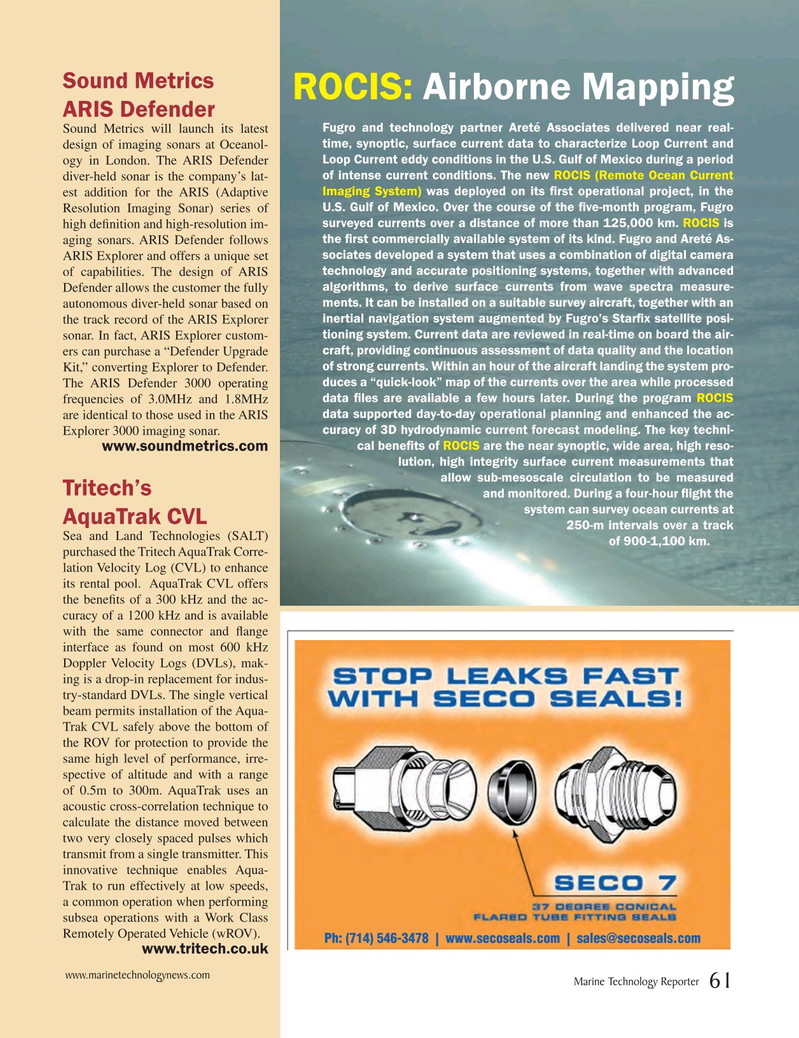
Page 61: of Marine Technology Magazine (March 2016)
Oceanographic Instrumentation: Measurement, Process & Analysis
Read this page in Pdf, Flash or Html5 edition of March 2016 Marine Technology Magazine
Sound Metrics
ROCIS: Airborne Mapping
ARIS Defender
Sound Metrics will launch its latest Fugro and technology partner Areté Associates delivered near real- design of imaging sonars at Oceanol- time, synoptic, surface current data to characterize Loop Current and ogy in London. The ARIS Defender Loop Current eddy conditions in the U.S. Gulf of Mexico during a period diver-held sonar is the company’s lat- of intense current conditions. The new ROCIS (Remote Ocean Current est addition for the ARIS (Adaptive Imaging System) was deployed on its ? rst operational project, in the
Resolution Imaging Sonar) series of U.S. Gulf of Mexico. Over the course of the ? ve-month program, Fugro high de? nition and high-resolution im- surveyed currents over a distance of more than 125,000 km. ROCIS is aging sonars. ARIS Defender follows the ? rst commercially available system of its kind. Fugro and Areté As-
ARIS Explorer and offers a unique set sociates developed a system that uses a combination of digital camera of capabilities. The design of ARIS technology and accurate positioning systems, together with advanced
Defender allows the customer the fully algorithms, to derive surface currents from wave spectra measure- autonomous diver-held sonar based on ments. It can be installed on a suitable survey aircraft, together with an the track record of the ARIS Explorer inertial navigation system augmented by Fugro’s Star? x satellite posi- sonar. In fact, ARIS Explorer custom- tioning system. Current data are reviewed in real-time on board the air- ers can purchase a “Defender Upgrade craft, providing continuous assessment of data quality and the location
Kit,” converting Explorer to Defender. of strong currents. Within an hour of the aircraft landing the system pro-
The ARIS Defender 3000 operating duces a “quick-look” map of the currents over the area while processed frequencies of 3.0MHz and 1.8MHz data ? les are available a few hours later. During the program ROCIS are identical to those used in the ARIS data supported day-to-day operational planning and enhanced the ac-
Explorer 3000 imaging sonar. curacy of 3D hydrodynamic current forecast modeling. The key techni- cal bene? ts of ROCIS are the near synoptic, wide area, high reso- www.soundmetrics.com lution, high integrity surface current measurements that allow sub-mesoscale circulation to be measured
Tritech’s and monitored. During a four-hour ? ight the system can survey ocean currents at
AquaTrak CVL 250-m intervals over a track
Sea and Land Technologies (SALT) of 900-1,100 km. purchased the Tritech AquaTrak Corre- lation Velocity Log (CVL) to enhance its rental pool. AquaTrak CVL offers the bene? ts of a 300 kHz and the ac- curacy of a 1200 kHz and is available with the same connector and ? ange interface as found on most 600 kHz
Doppler Velocity Logs (DVLs), mak- ing is a drop-in replacement for indus- try-standard DVLs. The single vertical beam permits installation of the Aqua-
Trak CVL safely above the bottom of the ROV for protection to provide the same high level of performance, irre- spective of altitude and with a range of 0.5m to 300m. AquaTrak uses an acoustic cross-correlation technique to calculate the distance moved between two very closely spaced pulses which transmit from a single transmitter. This innovative technique enables Aqua-
Trak to run effectively at low speeds, a common operation when performing subsea operations with a Work Class
Remotely Operated Vehicle (wROV).
Ph: (714) 546-3478 | www.secoseals.com | [email protected] www.tritech.co.uk www.marinetechnologynews.com
Marine Technology Reporter 61
MTR #2 (50-65).indd 61 2/22/2016 10:13:50 AM

 60
60

 62
62
